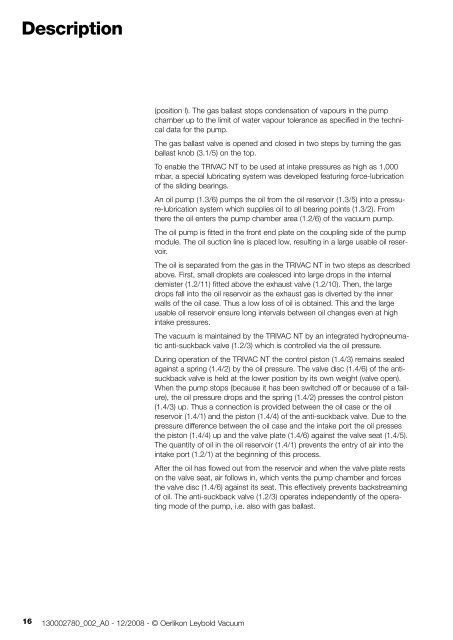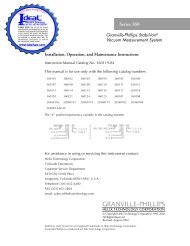Leybold Oerlikon, Trivac NT16, NT25, Rotary Vane Vacuum Pump ...
Leybold Oerlikon, Trivac NT16, NT25, Rotary Vane Vacuum Pump ...
Leybold Oerlikon, Trivac NT16, NT25, Rotary Vane Vacuum Pump ...
You also want an ePaper? Increase the reach of your titles
YUMPU automatically turns print PDFs into web optimized ePapers that Google loves.
Description<br />
(position I). The gas ballast stops condensation of vapours in the pump<br />
chamber up to the limit of water vapour tolerance as specified in the technical<br />
data for the pump.<br />
The gas ballast valve is opened and closed in two steps by turning the gas<br />
ballast knob (3.1/5) on the top.<br />
To enable the TRIVAC NT to be used at intake pressures as high as 1,000<br />
mbar, a special lubricating system was developed featuring force-lubrication<br />
of the sliding bearings.<br />
An oil pump (1.3/6) pumps the oil from the oil reservoir (1.3/5) into a pressure-lubrication<br />
system which supplies oil to all bearing points (1.3/2). From<br />
there the oil enters the pump chamber area (1.2/6) of the vacuum pump.<br />
The oil pump is fitted in the front end plate on the coupling side of the pump<br />
module. The oil suction line is placed low, resulting in a large usable oil reservoir.<br />
The oil is separated from the gas in the TRIVAC NT in two steps as described<br />
above. First, small droplets are coalesced into large drops in the internal<br />
demister (1.2/11) fitted above the exhaust valve (1.2/10). Then, the large<br />
drops fall into the oil reservoir as the exhaust gas is diverted by the inner<br />
walls of the oil case. Thus a low loss of oil is obtained. This and the large<br />
usable oil reservoir ensure long intervals between oil changes even at high<br />
intake pressures.<br />
The vacuum is maintained by the TRIVAC NT by an integrated hydropneumatic<br />
anti-suckback valve (1.2/3) which is controlled via the oil pressure.<br />
During operation of the TRIVAC NT the control piston (1.4/3) remains sealed<br />
against a spring (1.4/2) by the oil pressure. The valve disc (1.4/6) of the antisuckback<br />
valve is held at the lower position by its own weight (valve open).<br />
When the pump stops (because it has been switched off or because of a failure),<br />
the oil pressure drops and the spring (1.4/2) presses the control piston<br />
(1.4/3) up. Thus a connection is provided between the oil case or the oil<br />
reservoir (1.4/1) and the piston (1.4/4) of the anti-suckback valve. Due to the<br />
pressure difference between the oil case and the intake port the oil presses<br />
the piston (1.4/4) up and the valve plate (1.4/6) against the valve seat (1.4/5).<br />
The quantity of oil in the oil reservoir (1.4/1) prevents the entry of air into the<br />
intake port (1.2/1) at the beginning of this process.<br />
After the oil has flowed out from the reservoir and when the valve plate rests<br />
on the valve seat, air follows in, which vents the pump chamber and forces<br />
the valve disc (1.4/6) against its seat. This effectively prevents backstreaming<br />
of oil. The anti-suckback valve (1.2/3) operates independently of the operating<br />
mode of the pump, i.e. also with gas ballast.<br />
16 130002780_002_A0 - 12/2008 - © <strong>Oerlikon</strong> <strong>Leybold</strong> <strong>Vacuum</strong>
















